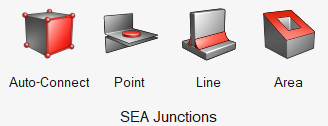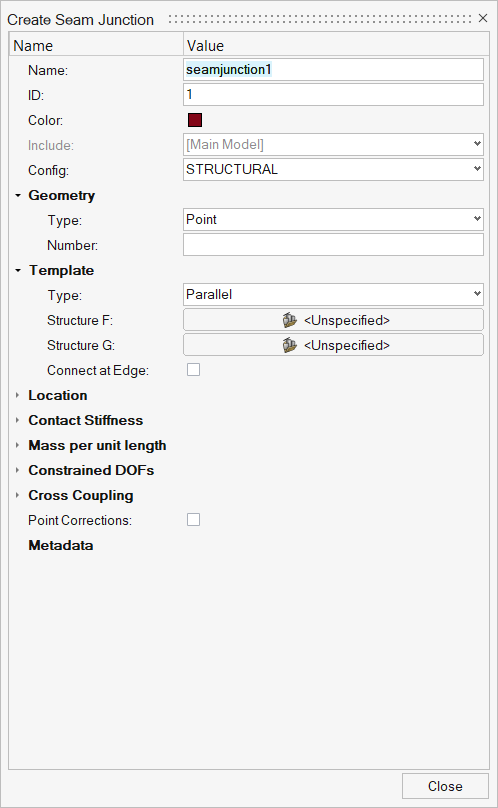SEA Junctions
A SEA junction is an energy flow path between two or more SEA subsystems corresponding to a single degree of freedom.

Figure 1. SEA Junctions Ribbon

Figure 2. Create Seamjunctions
- Junction
- A SEA junction is an energy flow path between two or more SEA subsystems corresponding to a single degree of freedom.
- Connection
- Defines how model elements are connected. Connections provide paths for vibration and acoustic power flow between elements and establish degrees-of-freedom at the element interfaces. A single connection contains one or more SEA junctions.
- Name
- Enter a unique name.
- ID
- Enter a unique ID.
- Connection type
- A predefined type which describes the general form of the connection. The connection type is chosen from the Config drop-down menu.
- Geometry
- Choose the type of structural connection and specify its dimension.
- Template
- A variety of connection templates are available. Template details (highlighted) are available.
- Contact Stiffness
- Model element contact stiffness (or element contact stiffness per unit length for line junctions) due to isolation systems. Stiffness values for various degrees of freedom are entered. A blank or zero stiffness indicates no isolation is present for the DOF. Multiple elements in a connection may be isolated. Frequency-dependent stiffness may be defined using a function.
- Mass per unit length
- Translational and/or rotational masses at a junction (or mass/length for line junctions) are specified in this section. A junction mass changes the junction impedance, which may reduce or otherwise change the coupling between the elements in the connection. A translational mass changes the junction impedance for all translational degrees of freedom and a rotational mass changes the junction impedance for all rotational degrees of freedom. Frequency-dependent masses may be defined using a function.
- Constrained DOFs
- Structural junctions typically involve translation and rotation through several degrees of freedom (DOF). This option allows you to block energy transmission through any DOF by constraining its motion. Physically, constraining a DOF in SEA means that the elements are free to move (translate or rotate) without causing a reaction or transmitting energy to other elements in the connection. This is opposite of the definition of a constrained DOF in an FEA model, where the elements at the DOF are rigidly constrained to have no relative motion.
- Cross Coupling
- Cross coupling junctions connect the bending and in-plane subsystems within the same structure. This coupling is observed for real-world structures, even when the junction appears symmetric.
